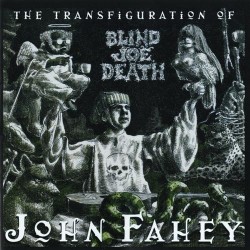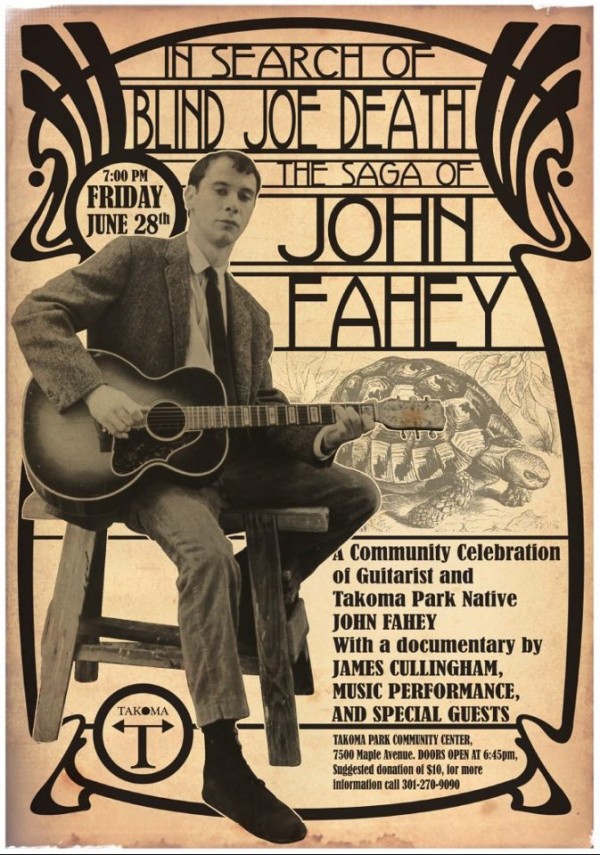JONATHAN VALANIA: Guitarist John Fahey — drifter, hermit, sorcerer — does for the blues, folk and other American primitive idioms what Duchamp did for nudes descending staircases: His sonic portraits never rely on blurry lines to illustrate the concentric circles of motion and being, managing to suggest the ancient, immediate and infinite all at once. Pretty heady stuff, and if the latter half of his 30-plus recordings sounds a little new age-y, well, you can’t blame him for the watery derivations his disciples managed to popularize. Though heralded as one of the great fingerstyle guitarists of the 20th century, Fahey’s itinerant 40 years of music-making bears the bite marks of as many hellhounds on his trail as any Delta bluesman. Rising iconoclastically out of the ’60s acoustic scene after having already recorded his touchstone works, 1959’s Blind Joe Death and 1963’s Death Chants, Breakdowns, And Military Waltzes, Fahey would alternately soar and stumble into a decades-long hermitage of bourbon, welfare and disease, his seclusion only adding to his mystique. In the ’90s, he emerged a wizened Buddha; a hipster Santa in his dark shades, white beard and pot belly, offering knee rides to a whole new generation of guitar scientists combing through the secret history of elder avant fingertsylists and obliging them with rare gifts from his Revenant label. MORE
THE GUARDIAN: Both John Fahey and Richard Brautigan were makers of mischief as well as myths, who played around with form and tradition. Both seemed to belong to an older era – on the Picador book cover of Trout Fishing In America, Brautigan looks like he would have been quite at home hanging with the Band at Big Pink. In many ways, they were artists in thrall to what Greil Marcus famously called “the old weird America”, the traces of which remained only in folk stories and ballads, in the oldest, most primitive-sounding versions of folk, bluesand country. But they were also, in their different ways, modernists negotiating their way mischievously and not altogether reverently into new forms, new languages. As I found out much later, The Transfiguration of Blind Joe Death was a title intended to confuse. Likewise the strange overblown sleeve notes – “A disgusting, degenerate, insipid young folklorist from the Croat & Isaiah Nettles Foundation for Ethnological Research meandered mesmerically midst marble mansions in  Mattapon, Massachusetts …” Fahey was having his own kind of fun at the expense of blues and folk music collectors, of which, ironically, he was one. The music, though, was something else: intricate, intriguing, multi-layered, resonant. It has stayed with me ever since, becoming, over the years, a constant.
Mattapon, Massachusetts …” Fahey was having his own kind of fun at the expense of blues and folk music collectors, of which, ironically, he was one. The music, though, was something else: intricate, intriguing, multi-layered, resonant. It has stayed with me ever since, becoming, over the years, a constant.
That music is, in the main, solo and acoustic, played on a steel-stringed guitar. I distinctly remember my younger self being somewhat wary of buying an entire album of acoustic guitar instrumentals, but the more I listened to The Transfiguration of Blind Joe Death playing in the background as I browsed the racks of a now long-gone second-hand record shop in Camden Town, the more it cast its spell. In Fahey’s hands, a single song can carry echoes of all the older musics he was drawn to – traditional folk ballads, blues, bluegrass, gospel, spirituals – but simultaneously sound somehow new and utterly unique. When he interprets an old song like John Henry or even Bicycle Built for Two, he reinvigorate it with the restless imagination of his playing. On Old Southern Medley, from The Transfiguration of Blind Joe Death, he even lists the musicians he is evoking: the great American songwriter Stephen Foster, Fahey’s beloved Charley Patton as well as Daniel Decatur Emmett, a self-taught songwriter and musician who founded the first blackface minstrel troupe in 1843.
Fahey’s tastes tended towards the old and overlooked, the strange and the primitive, and his guitar playing seems to summon up the spirits of long-dead blues and ragtime pioneers. More so than anyone apart from maybe the Bob Dylan of The Basement Tapes, he is perhaps the pivotal link between the various, almost-lost folk musics of another, older America and the singers and the contemporary musicians loosely grouped under the rubric of Americana. In a new documentary on Fahey, In Search of Blind Joe Death: The Saga of John Fahey, which has is doing the rounds of indie film festivals and will be shown by BBC4 in December, the musicologist Rob Bowman, notes: “It’s hard to imagine what contemporary music would be like if people like John Fahey had not been obsessively fascinated with roots American music from the 1920s and 30s. That’s the secret of a whole swathe of modern rock’n’roll. It was his sense of collage, soundscape and dissonance that influence people like [Pete] Townshend, Thurston Moore and Beck.” MORE
RELATED: In Search Of Blind Joe Death
RELATED: Blood On The Frets

